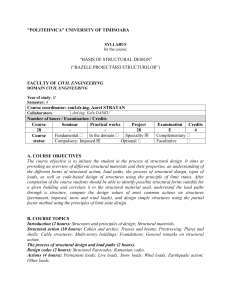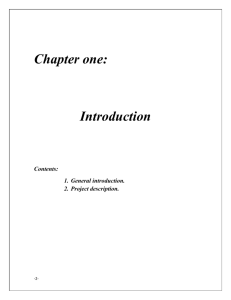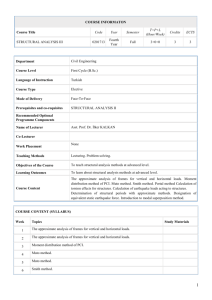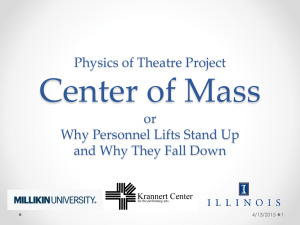Structures - Northern Highlands
advertisement
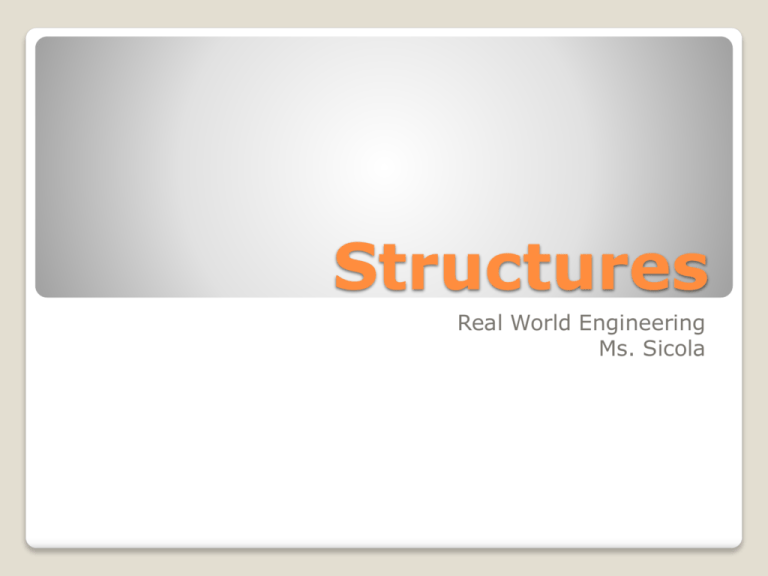
Structures Real World Engineering Ms. Sicola Live loads refer to loads that do, or can, change over time. Objects that move around in or on a structure, like people, furniture, and cars, are all examples of live load. In addition to live loads, what is known as environmental loads are loads that are created naturally by the environment and include wind, snow, seismic, and lateral soil pressures. Dead loads: The weight of the structure itself is called the dead load. Anything permanently attached to the structure is part of its dead load -- including the columns, beams, nuts, and bolts. These are loads that typically do not change over time. http://www.pbs.org/wgbh/buildingbig/lab/loads.ht ml Live loads vs dead loads Static loads are usually gravity-type loads. These would include the weight of the structure itself or any other load that is stationary. Dead loads are static forces that are relatively constant for an extended time. An elevator is an example where static loading occurs. When ten people stand in an elevator waiting for the doors to close, they are exerting a load on it that is static because the people and the elevator are not moving relative to each other. The stresses within the elevator have time to reach equilibrium under such conditions. Static Loads The lower columns of the skyscraper are squeezed by the heavy weight above them. This squeezing force in called compression. Compression is a force that squeezes a material together. When a material is in compression, it tends to become shorter. http://www.pbs.org/wgbh/buildingbig/lab /forces.html The weight of the roadway and all the cars traveling on the bridge pull on the vertical cables in this suspension bridge. The cable are in tension. Tension is a force that stretches a material apart. When a material is in tension, it tends to become longer. Compression vs. Tension Buckling occurs when an object bends and gives way under pressure or strain. Example above shows a pressure from both the top and sides causing buckling of this column. https://www.youtube.com/watch?v=NBcToktU 2oI http://www.pbs.org/wgbh/buildingbig/lab/forc es.html • Deflection is the degree to which a structural element is displaced under a load. It may refer to an angle or a distance. • Example shown below a bam subject to a point load at its mid-span where it will experience deflection. The neutral axis is an imaginary plane that runs through the center of a structural member and along which no stress occurs. Pressure is the continuous physical force exerted on or against an object by something in contact with it. Pressure can cause buckling in an object. Buckling, Deflection, and Neutral Axis Column or pillar in architecture and structural engineering is a structural element that transmits, through compression, the weight of the structure above to other structural elements below. In other words, a column is a compression member. Girders are a type of beam. There are two kinds of beams namely 'Primary beam' and ‘Secondary beam'. Girders comes under the category of primary beam, its main job is to directly transfer loads coming over it to columns upon which it rests. A Beam is a structural member which spans horizontally between supports and carries loads which act at right angles to the length of the beam. Furthermore, the width and depth of the beam are "small" compared with the span. Beams are considered secondary beams or, its main job is to first transfer loads on it to Girders or Primary beams which in turn transfer the loads to columns supporting it. Columns, Beams, Girders Cross Bracing Cross Bracing is a system utilized to reinforce building structures in which diagonal supports intersect. Dampening reduces the amplitude of an oscillation on an object or structure ◦ Examples include dampening on shock absorbers of the car suspension when it moves up and down, Tacoma Narrows Bridge collapse ◦ https://www.youtube.com/watch?v=xox9B VSu7Ok Taipei 101 Tower would sway back and forth up to 60cm (2 feet) each way within five seconds The Taipei 101 engineers included a 730-ton counter giant pendulum to act as a counter weight. Shock absorbers or dampers are added to the structure to dissipate the seismic shock Dampening The Tacoma Narrows Bridge collapse is an example of the torsion created from the violent winds/ oscillations that caused it to ultimately fail Torsion is a twisting force upon an object or structure The column above from the Parthenon shows how the column segments have slid past each other Shear is a force that causes parts of a material to slide past one another in opposite directions Twisting and Shearing WIND When wind blows on a structure, it is called wind load. Wind loads push horizontally on a structure. Cross-Bracing: Cross-bracing is an excellent way to stiffen a structure experiencing wind load. When the wind blows, the diagonal brace squeezes together and prevents the structure from flopping over. EARTHQUAKES When the ground beneath a structure jerks back and forth during an earthquake, the structure is experiencing an earthquake, or seismic load. Earthquake loads push and pull horizontally on a structure. They can also move vertically up and down https://www.youtube.com/watch?v=fqzTB dFa884 “P” waves (up and down) vs. “S” waves (side to side) Wind Force Vs. Earthquake Force OSCILLATION Oscillation is a motion that repeats itself in a regular cycle, such as a pendulum. Winds, Oscillations, Earthquakes EARTHQUAKES When the ground beneath a structure jerks back and forth during an earthquake, the structure is experiencing an earthquake, or seismic load. Earthquake loads push and pull horizontally on a structure. They can also move vertically up and down https://www.youtube.com/watch?v=fqzTB dFa884 “P” waves (up and down) vs. “S” waves (side to side) A P wave, or compressional wave, is a seismic body wave that shakes the ground back and forth in the same direction and the opposite direction as the direction the wave is moving. An S wave, or shear wave, is a seismic body wave that shakes the ground back and forth perpendicular to the direction the wave is moving. Winds, Oscillations, Earthquakes PSF or Pounds per Square Foot is a system of measurement used in engineering and architecture to understand the live load and dead load weight imposed on a structure Pound-force per square foot (psf) is a unit of pressure where a force of one pound-force (lbf ) is applied to an area of one square foot (ft²). 1 psf = 1 lbf / ft² PSF or Pounds per Square inch is a system of measurement used in engineering and architecture to understand the live load and dead load weight imposed on a structure Pound-force per square inch (psi) is a unit of pressure where a force of one pound-force (lbf ) is applied to an area of one square inch (in²). 1 psf = 1 lbf / in² PSI is most commonly used in architecture and engineering PSF vs PSI


